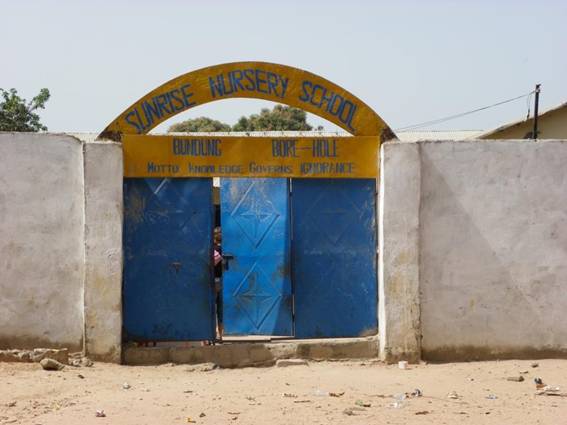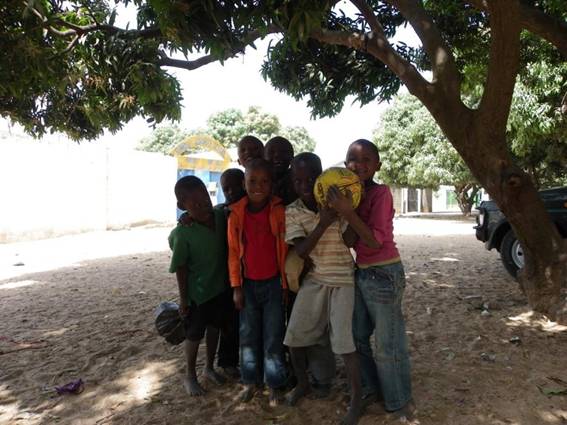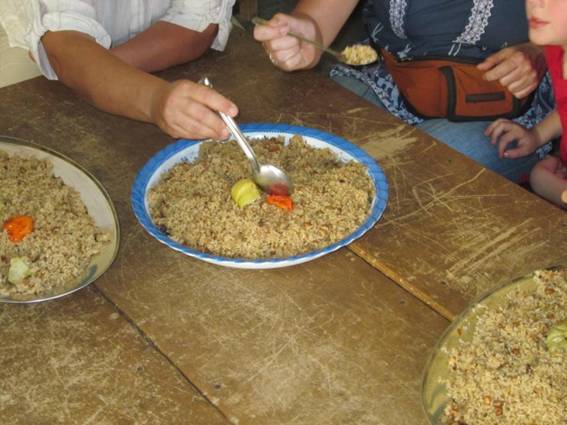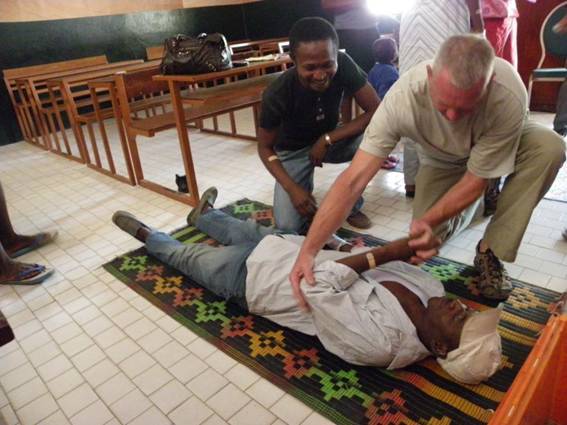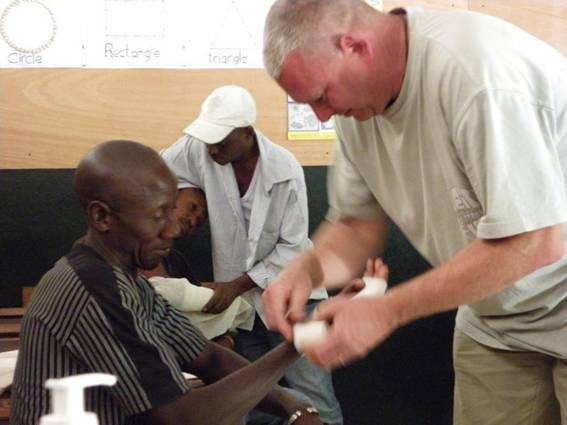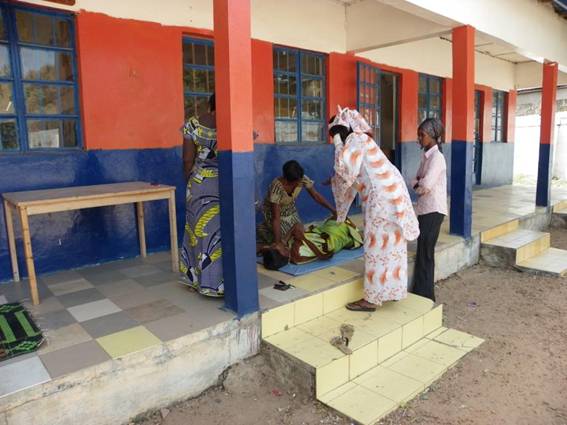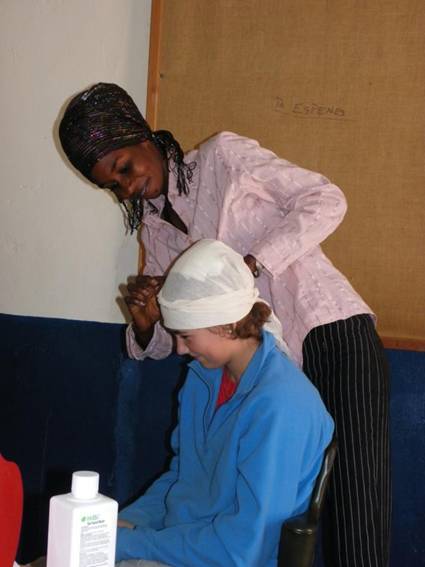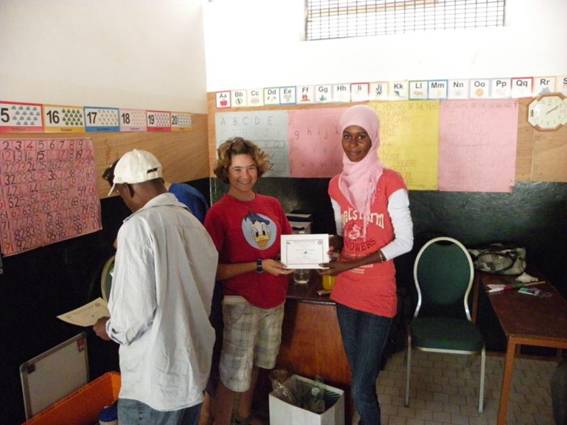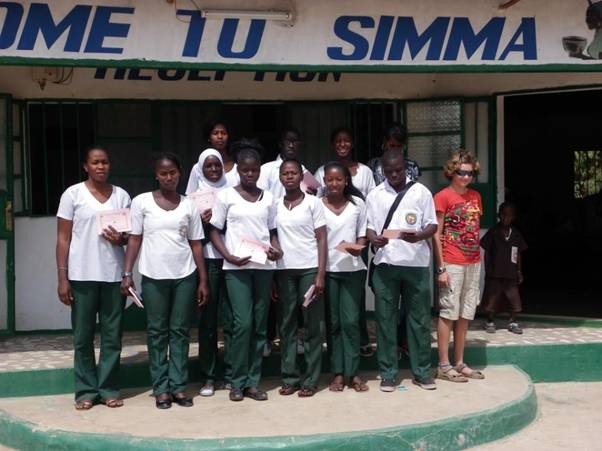Blog update: Dave's Gambian bit of the blog

For those of you who are avid readers of our blog and have long memories, you will remember that way back in May 2011 we did a charity concert at the Sailors Bar in Las Palmas. Sarah, Bethany, Bryn and I, along with Paul, Hilary, Kara, Senne, Marijn, Pete (plus a French guy who just happened to be there) played for 2 or 3 hours and raised enough money to set up a 1st Aid training day and provide a large box of First Aid kit for a nursery school here in The Gambia. FirstAid4Gambia is the charity that we supported and it is doing what it says on the box, or in this case the website http://www.firstaid4gambia.org/ and Facebook pages http://www.facebook.com/groups/148872820845/ ! It’s a small Scottish charity run by a brother & sister ‑ Bill and Fiona Nelson ‑ who give their time freely here in Gambia while still running a business back in the UK! At the moment they also have a German student (Nora) working with them until March and are training up two locals (Ali and Liney) to carry on the training when they are back in the UK. The kit that FirstAid4Gambia supply is what we would think of as a very basic kit, with loads of dressings, plasters, bandages, swabs, gloves, sterile hand wash, etc. But the most important thing they provide is the training on how to use it all. Shortly after arriving here in The Gambia we contacted Fiona, who arranged for us to be collected and delivered to the Sunrise Nursery at Bundung Bore-Hole (this is place where our money went), to see a training day take place and to help out if we could.
Yep, this is the place!
Some of the local children, posing for a photo.
Dinner consisted of a local dish called Bahaal (rice, ground nuts and flaked smoked fish with a garnish of bitter tomato and a very hot whole chilli). The training lasts a whole day, with a break for dinner and sometimes for prayers as well, so patience is also a good skill to have. Anyway, a general day consists of: · Showing people how to use disposable gloves (with 25% of the population HIV-positive, you need these!), and how to wash and clean a wound · putting on a basic plaster (not so easy with gloves on!) · basic dressing and bandaging a large wound and how to use a triangular bandage · fits · putting a casualty into the recovery position · CPR ‑ loads of practical training using an adult and child Resus-Annie · burns and scalds · choking · nose bleeds · sprains and strains.
Demonstrating how to put somebody into the recovery position.
The women getting into the swing of things with the recovery position and CPR
Bethany being a good casualty in the safe hands of Ali, one of the trainers. As I said, it is a very basic 1st Aid course but it does work and it is saving (has already saved) lives in the communities where it’s being taught! Part of what I wanted to do in The Gambia was to help out where I could, so I have since been working with the charity in other nurseries and an adult education centre delivering 1st Aid courses. All of these places have been vastly different experiences with a huge discrepancy in funding for the schools concerned. Some have very little in the way of teaching aids and facilities and others have it all, including a computer centre and a small but extremely well-stocked medical store. The better schools are supported by various means, sometimes by rich individuals other times by external charities – many are funded by Norwegian and Dutch charities, which is surprising as this is an ex-British territory and we (the British) are very absent from stuff going on here. But, the thirst for knowledge in all of these schools is the same, be it from the staff with the training we are giving, or from the children who are proud to be at school and just want to learn. Bethany has surprised us all by her keenness to help out and get involved with the charity, helping on every course that she can, demonstrating how to bandage, put people in the recovery position, CPR, and be the “casualty” when needed. As well as this, she has also helped in visiting various schools prior to the 1st Aid course to check on their training needs and what kit they have used over the previous 12 months, so working out what needs replacing. After helping out on her second training day, she even received her 1st Aid certificate to prove she was qualified, that means we now have two qualified 1st Aiders on board!!!!!!
Bethany getting her 1st Aid certificate. We all think of basic 1st Aid as being common sense, but this is Africa and here things are ever so slightly different to what you’d expect in Europe ‑ treatments for simple things are shrouded in myth, misinformation, fear and the local ‘Mamoot’ (Witch Doctor) still wields a great deal of power, a bit of fear and quite a bit of respect! Treatment for burns (severe or not), for example, is likely to be the application of something like toothpaste, tomato paste, egg, soot from the base of the pan, ash, butter and/or a whole load of other stuff over the affected area. Cool or cold running water would not be considered as a suitable treatment for burns most of the time! While things like epileptic fits and hiccups are still considered as signs of possession by a devil, so the people (children in this case) would be stopped from leaving their compound and in some cases even ostracized from a community, as other parents won’t want their children around them in case the devil possesses them as well! So, a basic education on stuff like this is also part of the training day.
Simma Adult Education Centre teaching 1st Aid along with City & Guilds. Other things you have to remember are religion and cultural differences; some of the training is single sex, while other times the men won’t touch the women and vice versa. Even things like having naked female flesh (such as a bit of leg) showing will be addressed before doing any 1st Aid, so getting people to understand that saving a life is more important than which gender the casualty is or if their legs are showing can be difficult. So, blend all of this in with 1st Aid training, the colourful and vibrant Gambian people and add heat, smells, a general buzz for life and a healthy thirst for knowledge and you get really interesting training days to say the least. While medical treatment in The Gambia is in theory free (going to the clinic and seeing a doctor at least) the cost of treatment (drugs, dressings, etc) is out of reach for 90% of the population, so most people don’t go and quite a few lives are lost because of it. So the whole school community benefits with the 1st Aid kit being available to the parents as well as the children, under the control of the Headmaster; in some cases even the local football team has a call on the crepe bandages and ‘the school’ 1st Aid kit for important matches! FirstAid4Gambia is really getting out there and into the community with its new and ongoing training programmes, it’s a small charity and in need for some serious sponsorship in getting the kit and qualified trainers to where it is needed, so if you have any spare money, maybe you can give them your support as well? |
